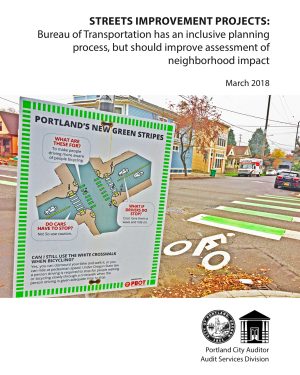
Projects completed by Portland’s transportation bureau are making streets safer, but the agency should do more to assess how surrounding neighborhoods are impacted by changes to traffic patterns.
That’s the key takeaway from a report released today by the Portland City Auditor.
The audit looked at 14 recently completed Portland Bureau of Transportation projects and selected two for closer analysis. They looked at safety projects on East Burnside (SE 15th to Laurelhurst Place) and on SE Division (from 60th to 80th). In both projects PBOT applied standard safety upgrades like lane reconfigurations, improved crossings and lower speed limits.
In both projects the City Auditor found that PBOT met their stated goals of safety and maintaining access to businesses.
However, the report says PBOT needs to take a closer look at what happens to adjacent streets and business patterns after projects are completed.
In the case of East Burnside, the audit says a 14 percent decrease in morning peak-hour auto volumes on the project street and a 117 percent increase in traffic on adjacent NE Couch means more analysis is needed to assess how that change affects local businesses and residents. “It would be important to know,” the audit states, “if they were adversely affected by the diversion of cars to adjacent streets.”
On Division, a lane reconfiguration and other changes led to a major decrease in crashes and the amount of speeding by drivers. Diversion to other streets wasn’t an issue; but the Auditor said PBOT needs to do an analysis of how the neighborhood was impacted.
Advertisement
Here’s an excerpt from the audit:
“As these two projects demonstrate, the Bureau uses measures to evaluate traffic safety and usage outcomes to determine whether some project goals were met, but had not developed indicators to measure livability outcomes. Determining how a project affected the neighborhood – such as whether businesses experienced an impact on their operations, what changes residents had to make to their commute, or how they accessed local shops and schools – may require management to commit resources to broader evaluation.”
And the recommendations are:
1. Develop and fund a consistent evaluation process that includes livability and neighborhood impact assessments
2. Use the results from project evaluations to inform the City’s future transportation plans and priorities.
PBOT Director Leah Treat has reviewed the audit and says they’re already working on the issue. “PBOT agrees that our project delivery process would benefit from additional measurement and evaluation practices.” Treat pointed to Portland Streetcar as an example of the type of reporting her agency would like to do. Streetcar publishes an annual report that’s easy to read and includes clear data about the impact of their impacts.
“We are taking steps to increase our ability to implement similar practices in PBOT project evaluation,” Treat wrote in the letter. “In the past year, the bureau has added additional positions that will help us increase these activities. Within the Business Services Group, we have created an Office of Strategy, Innovation and Performance. The development of improved project performance and evaluation metrics are part of their assigned activities but have not yet been formalized. This team currently has added two staff to date and is finalizing the hiring for a third.
In addition, PBOT recently added a Vision Zero Data Analyst position in our Policy Planning and Projects group to improve our evaluation of crash and overall safety and comfort performance data. This work will assist in project identification and scoping of improvements as well as evaluate improvements after they are implemented.”
Check out the Auditor’s report here (PDF).
— Jonathan Maus: (503) 706-8804, @jonathan_maus on Twitter and jonathan@bikeportland.org
Never miss a story. Sign-up for the daily BP Headlines email.
BikePortland needs your support.

